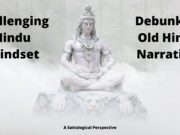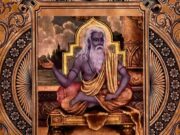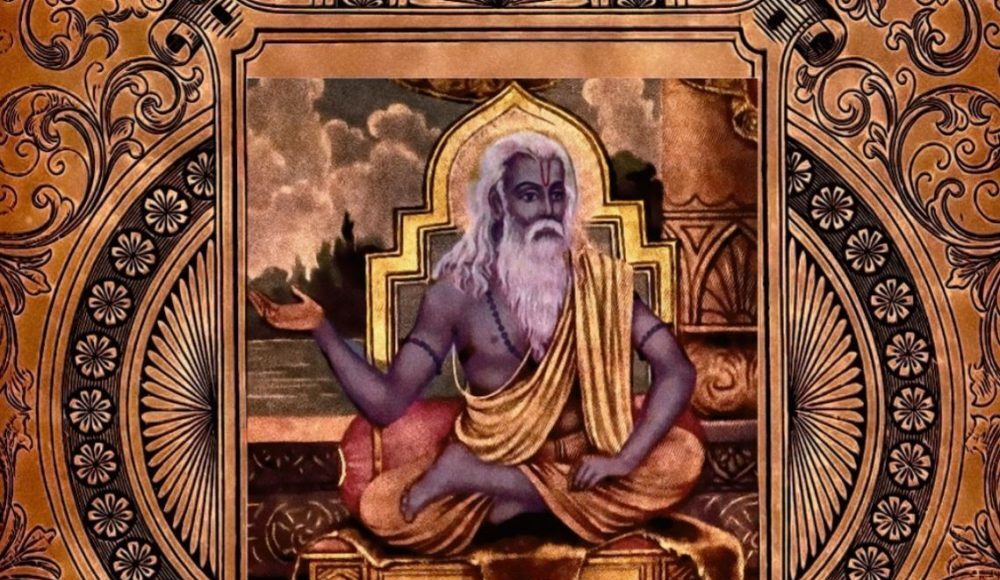तत: सप्तदशे जात: सत्यवत्यां पराशरात् ।
चक्रे वेदतरो: शाखा दृष्ट्वा पुंसोऽल्पमेधस: ॥ २१ ॥
The seventeenth incarnation of Vishnu is Vyasadeva, the son of Parashara and Satyavati. He divided one Veda into four and then explained them into Puranas and Mahabharata.
Considering the quality and intellectual capacity of people in the age of Kali will be very less as compared to other ages. Therefore, Vedas were put down in the written format. Vyasadeva’s disciples were very prominent in the whole history documentation from the vedic perspective that we know of.
Suta Gosvami explains to Shaunak Rishi, “The original sound vibration of the universe is heard in the space of Brahma’s heart when he becomes mature in the art of Self-Realization. That sound vibration can be easily perceived in everyone’s heart when they stop all external hearing.” This subtle form of Veda purifies the heart of Yogi of all material contamination. From this subtle form of Veda originates OmKara which consists of three subtle sounds. This sound vibration sustains the threefold stages of material consciousness and existences. From these sound vibrations Brahma created Vowels, Consonants, Sibilants, semivowels and other sounds that are differentiated by long & short measure. Using these sound vibrations, with his four mouths, he created four Veda combined into one, seven Vyahriti (goals) and Omkara. Brahma taught this knowledge to his sons and they taught to their own sons.
Using these sound vibrations, with his four mouths, he created four Veda combined into one, seven Vyahriti (goals) and Omkara. Brahma taught this knowledge to his sons and they taught to their own sons.
Thus, throughout the cycle of four ages, this Vedic education is taught through this disciplic succession to teachers after teachers. However, at the end of each Dwapara Yuga, this knowledge of Veda is edited into multiple subdivisions by eminent sages.
Noticing that in the age of Kaliyuga, people have diminished lifespan, intellect and intelligence as compared to earlier Yuga, great sages divided this knowledge from Veda into many sub branches.
अस्मिन्नप्यन्तरे ब्रह्मन् भगवान्लोकभावन: ।
ब्रह्मेशाद्यैर्लोकपालैर्याचितो धर्मगुप्तये ॥ ४८ ॥
पराशरात् सत्यवत्यामंशांशकलया विभु: ।
अवतीर्णो महाभाग वेदं चक्रे चतुर्विधम् ॥ ४९ ॥
Therefore, Brahma, Shiva and other Lokpal (Protectors) requested Hari, to protect the eternal principles of religion. Thereafter, a plenary portion of a portion of Hari entered the womb of Satyavati through the mind of Parashar Rishi to divide one Veda into four. This portion of Hari was called Vyas. Vyasadeva separated the mantras of Rg, Yajur, Sama, and Atharva into four just like a jeweler separates precious gems into four piles. These four sections of Veda were called samhita or treatise.
पैलाय संहितामाद्यां बह्वृचाख्यां उवाच ह ।
वैशम्पायनसंज्ञाय निगदाख्यं यजुर्गणम् ॥ ५२ ॥
साम्नां जैमिनये प्राह तथा छन्दोगसंहिताम् ।
अथर्वाङ्गिरसीं नाम स्वशिष्याय सुमन्तवे ॥ ५३ ॥
Paila was given Rg Samhita and this was named Bahvricha. Vaishampayan was given Yajur Samhita which was known as Nigad. Jaimin was given Saama Veda which was called Chandoga samhita. Atharva – Angira samhita was given to Sumantu.
In this way Vedas were given to these four principal sages to be shared with all of us.
Disclaimer: The views expressed are personal to the author
Please donate to support Hindu causes















